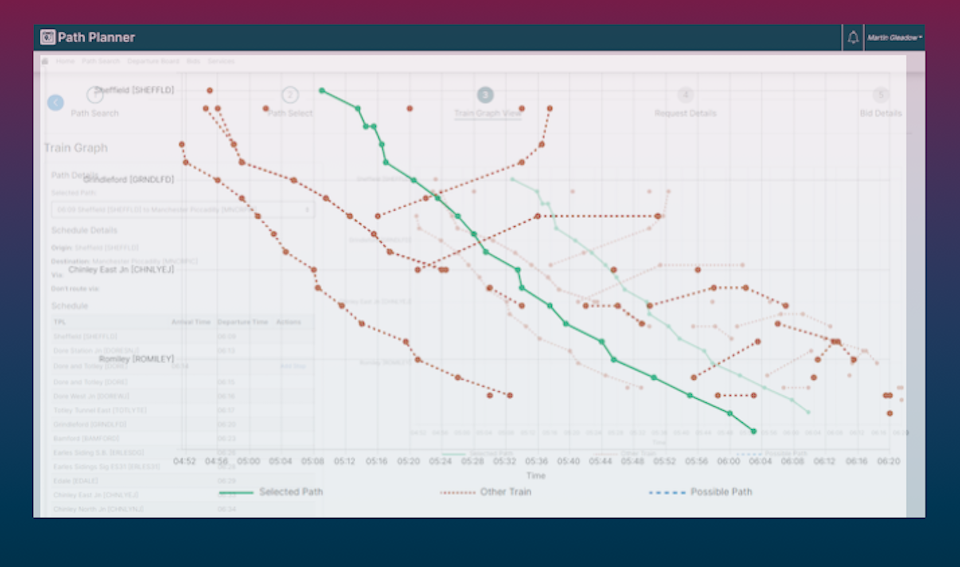UK’s 3Squared could make freight train scheduling easier

Rail technology specialists 3Squared are just months away from deploying their PathPlanner software solution, which they believe will make far better use of spare network capacity. The PathPlanner is designed to assist in finding a slot for freight trains amid the busy schedules of the UK network and has already caught the interest of the industry at large.
Capacity planning in the UK rail network still relies heavily on paperwork and outdated processes. 3Squared, the Sheffield-based experts say their tool could make the difference and bring train scheduling to the 21st century, especially in the short term and very short term planning arena.
A solution that is easier and cheaper
In an effort to reach a net-zero carbon economy by 2050, UK government mandates call for far more freight to be conveyed by rail. However, answering that call by providing additional network capacity is an expensive business, as debated at this week’s European Railway Summit. “We’re supporting the strategic aims of the government and Network Rail”, says lead engineer for the PathPlanner project, Martin Gleadow. “Right now, it’s a labour intensive operation to find a short notice freight path. It’s our aim to put a solution in there, that’s much easier, and therefore cheaper, for freight operators to implement, and make it more competitive for rail freight to pick up loads and traffic.”

The nature of train planning still remains a largely paper-based exercise, explains Gleadow. “That makes it very difficult to take advantage of any ad-hoc capacity, and the whole system relies very much on the local knowledge and experience of train planners. Despite the excellent job they do around the network, it just isn’t possible to take advantage of all the opportunities for capacity. PathPlanner doesn’t make the train planner redundant. It makes them superheroes for rail freight operators.”
Unlock existing capacity
PathPlanner should mop up any booked paths that remain unused on any given diagram, especially where that capacity comes ‘back on the market’ in the very short term. “Network Rail regularly provide operators with details of how heavily they are using their paths – but the industry set up is not very conducive to exploiting that capacity”, observes Gleadow. “PathPlanner can help unlock that existing capacity, be that out of Felixstowe, or a jumbo train out of Southampton.”
Given the tightening economic situation, the ability of PathPlanner to help identify existing unused capacity has obvious attractions for the government. 3Squared does not overtly advocate abandoning any direct infrastructure enhancements, but they do say their software solution can help now. They point out it can help bridge the gap between immediate ambitions to grow the rail freight sector and the lead time to deliver wholesale network enhancements.
Message for Great British Railways
Comparing rail paths and airport landing slots, Gleadow points out the difference of attitude, which sees airline operators adopt a ‘use it or lose it’ mentality. That does not exist in the rail freight industry. “There is very much a difference of attitude between running a path and owning a path”, says Gleadow. “We are working very closely with the Rail Freight Industry to get ‘buy-in’ from the industry at large. There are lots of pockets of work going on, but depending on the context, there is not a concerted effort to address the capacity issue right now.”

“The Department for Transport [the UK government body] has to ask how to manage access and capacity. The advantage of software as a solution, as opposed to engineered capacity development, is a huge benefit that may not be readily incorporated into industry business planning. As the Network Rail bid process for paths becomes more screen-based, PathPlanner can greatly reduce the labour, eliminating a lot of rekeying and making the whole operation more reliable.”
The impetus is all about growth, concludes Gleadow. He says trying to fit new business into the existing network is expensive, and he argues PathPlanner is the most cost-effective and future-proof way to achieve that. Gleadow is confident that message will sit well with the soon to be activated Great British Railways, who, as the new network operator, could well be looking for effective and economic fixes as they take over the management of the network.
You just read one of our premium articles free of charge
Want full access? Take advantage of our exclusive offer





No matter what fancy tricks you play on computer technology if the capacity isn’t there it’s not there!Although the initial outlay for building in extra capacity is expensive once it’s built it’s there to use for hundreds of years-at little extra cost!The Werrington junction fly under being an example!The best thing for capacity for intermodal from Southampton would be reopen the Stockbridge line direct from Winchester to Didcot for freight only-avoiding the bottleneck at Basingstoke&Reading.
Still, if by most sophisticated “predictive” maintenance, corresponding on track machineries currently call for too costly obstructions, stops, etc. This is not sustainable, now when the “old railway” has to meet a steady flow of new, tough, competition – and clients demanding “On Time” supplies.
(Neither, Problem, voids and corresponding undampened “hung sleepers”, causing resonances at “pin pin” frequency…, etc. no longer shall plague, with high noise, etc…)